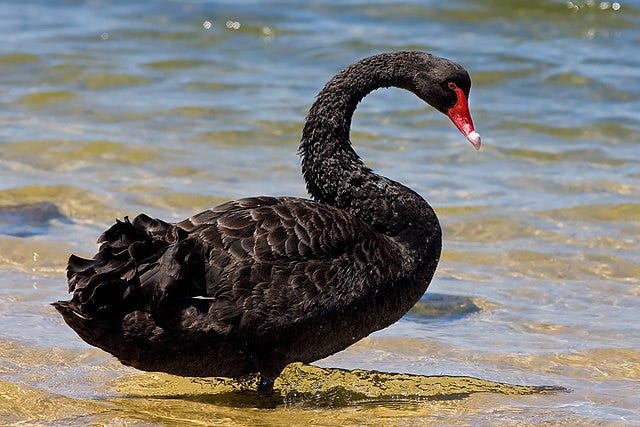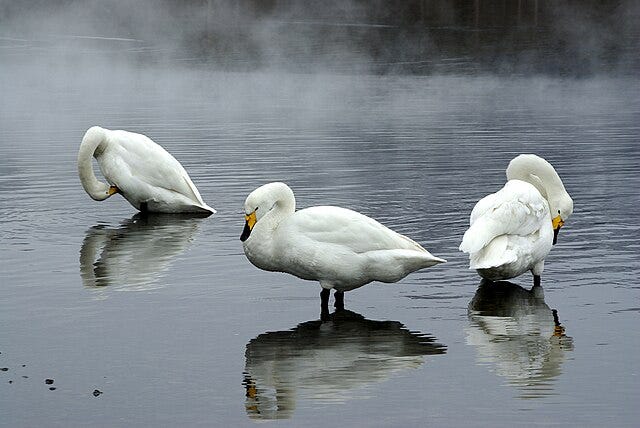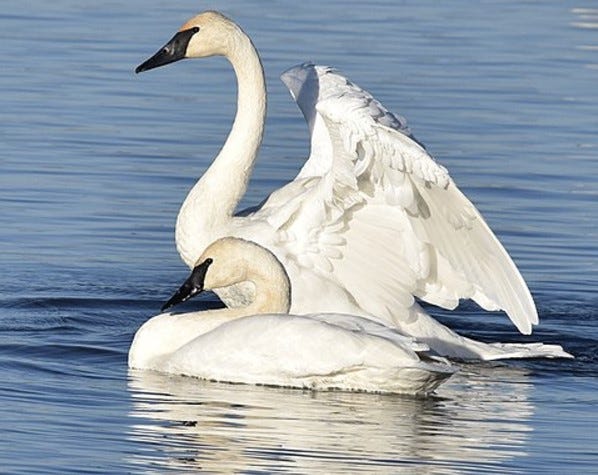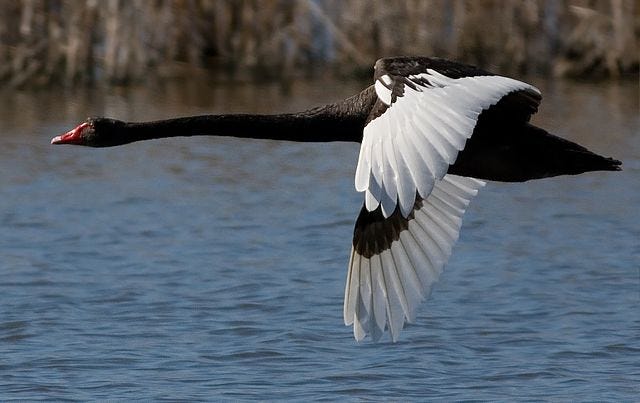Making Predictions: The Black Swan Conundrum
Are white swans the polar bears of the duck world?
At a conference I attended in 2011, Australian geologist Bob Carter began his lecture with the story of the discovery of Black swans in Australia by early European explorers. These men were astonished to see such a creature because for centuries, if not thousands of years, there had been a belief that swans were always white: Europeans knew only the all-white Mute swan, Cygnus olor, and Whooper of Eurasia, Cygnus cygnus.
Even swans they might have seen in North America were all-white, as shown below.

Their Northern Hemisphere experiences told these explores that a black swan could not exist.
Recently, this attitude led to a concept known as ‘black swan theory’, a metaphor developed in 2001 to describe a very rare and unpredictable event with potentially severe consequences. I’d never heard of black swan theory but was intrigued by Carter’s story for another reason.
Given my interest in speciation, especially of white and/or spotted animals like dogs, cows, and polar bears, I mulled over the issue of swan evolution on the way home from the conference. Evolutionarily speaking, which came first, I wondered: all-white swans or black ones?
I’d never thought about this particular example before. Could I predict the answer based on the thyroid hormone rhythm theory I developed for my 2004 dissertation, knowing that thyroid hormone has a huge influence on developmental rates and timing of growth in embryos?1
I recalled from Professor Carter’s lecture images that black swans (Cygnus atratus) are not all black—they have white flight feathers, and technically speaking, are piebald or white-spotted, as shown below. They have a red beak and the same kind of elegantly curved neck as the all-white mute swan.
I soon discovered that another Southern Hemisphere swan is also piebald: the black-necked swan, Cygnus melancoryphus, of South America, which is all-white except for a black neck, as shown below.
I knew that animals are piebald due to a developmental delay in the embryo that keeps pigment cells that produce black or other colors from reaching their destination. In other words, most all-white animals are simply ‘one big spot’ due to a complete developmental delay in the embryonic movement of these pigment cells. I therefore surmised that piebald swans from the Southern Hemisphere must be the ancestors of Northern Hemisphere all-white swans.
This would follow the pattern of all-white coloration being an inevitable consequence of the speciation process, just like the all-white pelage of the polar bear is a consequence of descent from a brown bear ancestor that often has white neck markings. At any rate, that is what my thyroid hormone theory would predict, as described in my recent book, Polar Bear Evolution: A Model for How New Species Arise.
After I got home, a bit of research located a 1996 paper on the evolutionary relationships of swans, geese and ducks by Bradley Livezey based on fossil and modern skeletal features.2
Livezey’s evidence indicated that both of the piebald Southern Hemisphere swans (the black swan and the black-necked swan) are the oldest species and ancestral to the all-white Mute swan of Eurasia and the all-white swans of North America, including the Trumpeter swan, Cygnus buccinator and the Tundra or Whistling swan, Cygnus columbianus.
A more recent analysis of mtDNA from individuals in the entire swan, goose, and duck group by Zhonglou Sun and colleagues in 2017 came to the same conclusion.
Southern Hemisphere black-and-white swans are the oldest species and all-white swans of the Northern Hemisphere are the youngest. It appears from this evidence that the black-necked swan (C. melanocoryphus) is ancestral to them all, and ironically, the Mute swan is more closely related to the Black swan than it is to the other all-white swans of North America.3

My prediction that piebald swans of the Southern Hemisphere should be the ancestors of all-white swans of the Northern Hemisphere was correct.
This is one of the reasons I feel confident about my thyroid rhythm theory: it can be used to make initial predictions of evolutionary relationships that are testable even before full endocrinological scrutiny is possible.
Crockford, S.J. (2004). Animal Domestication and Vertebrate Speciation: A Paradigm for the Origin of Species. Ph.D. dissertation. University of Victoria, Canada. http://hdl.handle.net/1828/542
Crockford, S.J. (2023). The species problem and polar bear evolution. ResearchGate preprint, https://doi.org/10.13140/RG.2.2.20218.06089
Crockford, S.J. (2023). Polar Bear Evolution: A Model for How New Species Arise. Amazon KDP, Victoria.
Livezey, B.C. (1996). A phylogenetic analysis of geese and swans (Anseriformes: Anserinae), including selected fossil species. Systematic Biology 45(4), 415-450.
Sun, Z., Pan, T., Hu, C., et al. (2017). Rapid and recent diversification patterns in Anseriformes birds: Inferred from molecular phylogeny and diversification analyses. PLoS One 12(9), e0184529. Open access https://doi.org/10.1371/journal.pone.0184529










When I was four years old, my mother made plaster swans and fish for bathroom walls. She sent me out to sell them to the neighbours for 25 cents. The swans were all black. One of the neighbours asked me if we had any white swans. My mother said black swans look better on white walls and are less likely to be knocked down because they can be seen.
I was wondering if developmental delays in embryos can be related to shouter seasons in the far north. The ones that become white are harder to knock off.